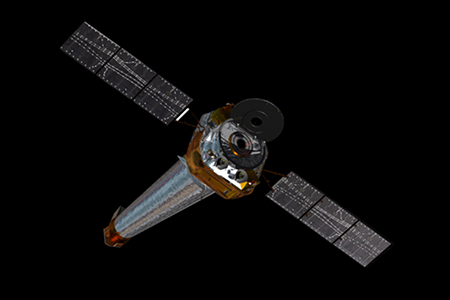Carnival of Space
Many of this week's blogs focused on that little-known telescope that's being invaded by a spaceship. In case you missed it, the telescope is called "Hubble" and the spaceship is our Space Shuttle Atlantis. Naturally, the astro-blogosphere took notice. In his "Dynamic of Cats" blog, Steinn Sigurdsson talks about the last pretty picture to come out of that workhorse instrument with the stubborn screw -- Wide Field/Planetary Camera 2.

The Bigger Picture
Take a look at "The Bigger Picture," a blog produced by the Smithsonian Photography Initiative (SPI). It aims to present an inside look at the Smithsonian's photography collections and invites audiences to engage in an online discussion about photography's powerful impact on our world. We contributed a post on "Seeing the Invisible (part I)" that you might enjoy: http://blog.photography.si.edu/2009/05/11/seeing-the-invisible/
-Kim Arcand, CXC
An Intriguing Glowing Galaxy
Activity from a supermassive black hole is responsible for the intriguing appearance of this galaxy, 3C305, located about 600 million light years away from Earth. The structures in red and light blue are X-ray and optical images from the Chandra X-ray Observatory and Hubble Space Telescope respectively. The optical data is from oxygen emission only, and therefore the full extent of the galaxy is not seen. Radio data are shown in darker blue and are from the National Science Foundation's Very Large Array in New Mexico, as well as the Multi-Element Radio-Linked Interferometer Network in the United Kingdom.
Chandra's One-time Shuttle Trip
This week, the Space Shuttle Atlantis will return to the Hubble Space Telescope for a fifth and final time. The mission will bring the telescope new instruments, batteries, and gyroscopes that will extend its lifetime for hopefully several years or more.
This year marks the 10th anniversary that the Shuttle launched and deployed Chandra . There haven't been any visits since and none will ever take place. That's because Chandra was designed to be different than Hubble -- in more ways than just the type of radiation it detects.

Resolving a Galactic Mystery
An extremely deep Chandra X-ray Observatory image of a region near the center of our Galaxy has resolved a long-standing mystery about an X-ray glow along the plane of the Galaxy. The glow in the region covered by the Chandra image was discovered to be caused by hundreds of point-like X- ray sources, implying that the glow along the plane of the Galaxy is due to millions of such sources.
Meet an Astronomer: Eli Bressert
In this latest installment of our series, we sit down with Eli Bressert. Eli is responsible for making the Chandra images for the public that appear in press releases, on the website, in posters, etc. While we won't get into the technical details of how that gets done in this video blog, we did want to point out that this an important -- if lesser known -- job in the world of space science.
"Hand"ling Information in Today's World
We've been publicizing and distributing Chandra results for nearly ten years now. One interesting trend we've watched over this time is how much things have changed in how people get their information. Back in the day, we would write a press release - sometimes even printing on paper! – and this would go to science reporters, who, in turn, would write articles for their newspapers, radio programs, or TV reports. The public would generally learn about our results by seeing them through these outlets.
Cosmic Heavyweights in Free-For-All
This composite image shows the massive galaxy cluster MACSJ0717.5+3745 (MACSJ0717, for short), where four separate galaxy clusters have been involved in a collision, the first time such a phenomenon has been documented. Hot gas is shown in an image from NASA's Chandra X-ray Observatory and galaxies are shown in an optical image from NASA's Hubble Space Telescope. The hot gas is color-coded to show temperature, similar to a temperature map of the Earth given in a weather forecast.
Celebrating Telescopic Diversity
This week, we released a new result that combines data from Chandra with two other telescopes (MacsJ0717.) The truth is that the multiple-telescope approach is  probably no longer the exception - rather it has become the rule.
probably no longer the exception - rather it has become the rule.
Is it Easy Being Green?
Solar panels have been in the news a lot lately. First, the Space Shuttle Discovery launched to bring the final set of solar panels to the International Space Station. Then the astronauts onboard the ISS got a call from an interested member of the public - President Barack Obama - who wanted to talk, among other things, about how the ISS uses solar power to generate its energy.
Well, as it turns out, the ISS is far from the only spacecraft up there using solar power. John Scott, a mission planner for Chandra's Flight Operation Team, describes how NASA's premier X-ray observatory is as green as can be.


